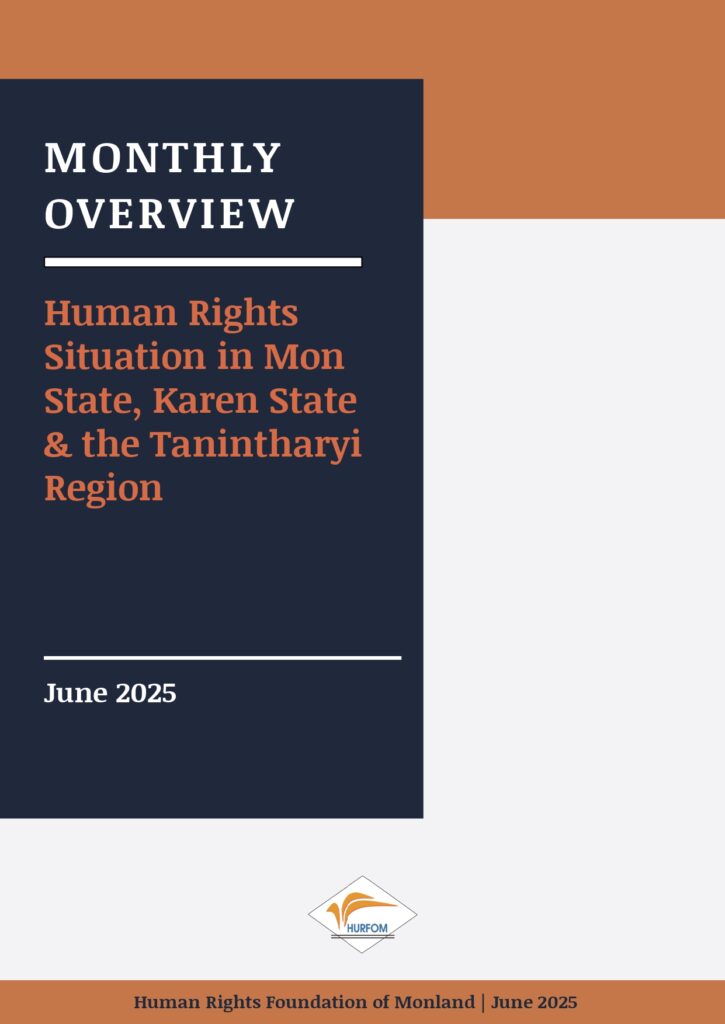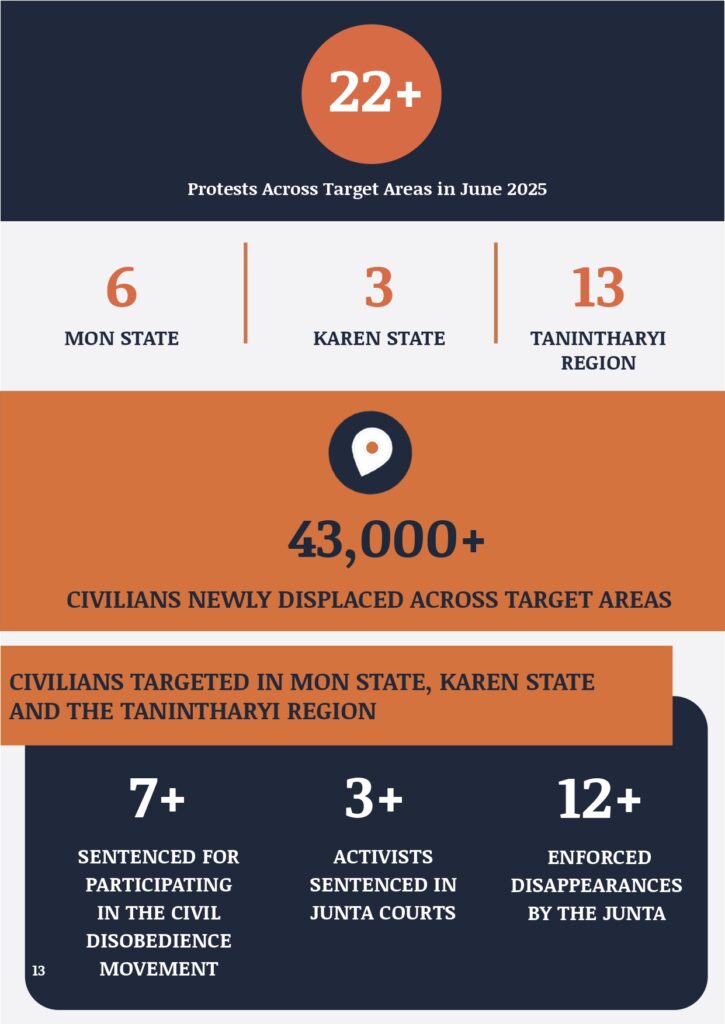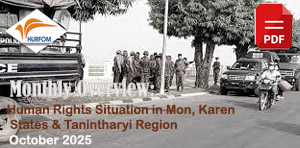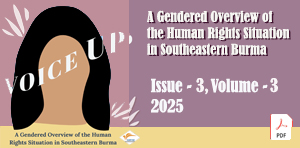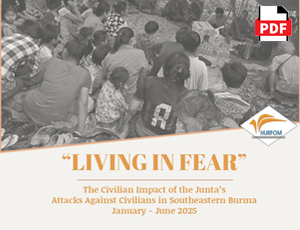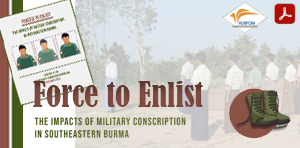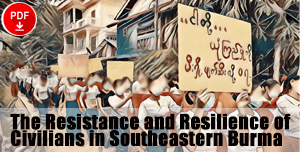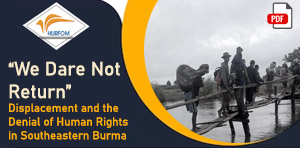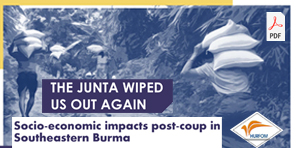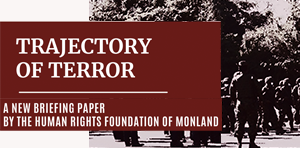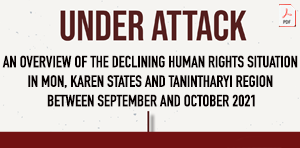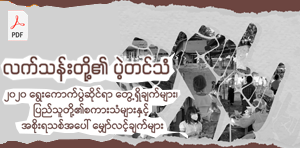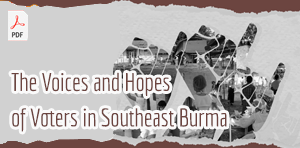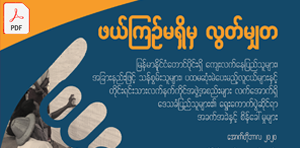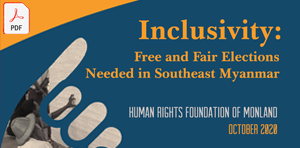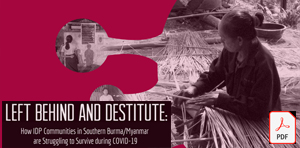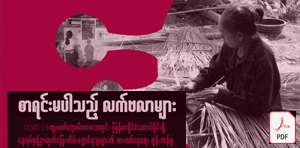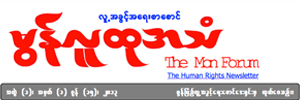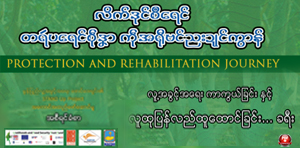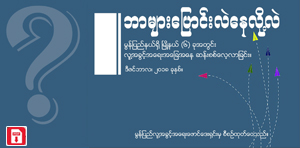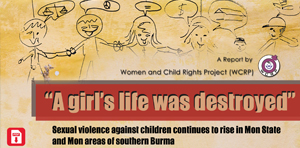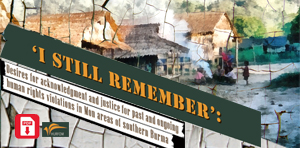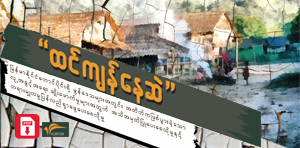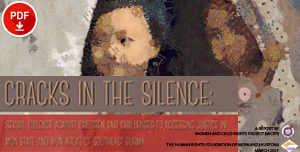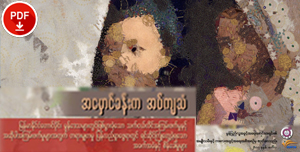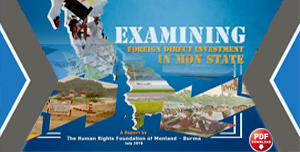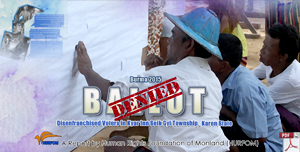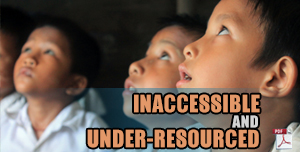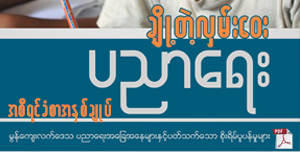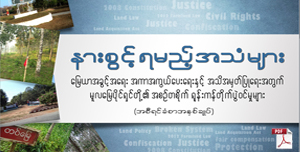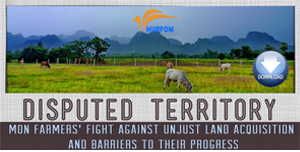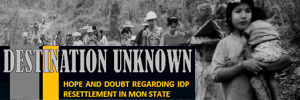Monthly Overview: Conflict-Affected Refugees and Internally Displaced Persons in Southeastern Burma Face Ongoing Threats to Their Safety and Security Due to Junta Attacks
June 30, 2025
The lack of urgent intervention by the international community in Burma has caused a continuous decline in human rights. Civilians across the country feel overwhelmed by a conflict that forces them to live each day in constant fear and uncertainty due to the absence of consequences and accountability for the illegal actions of the military junta. In specific areas of the Human Rights Foundation of Monland (HURFOM), including Mon State, Karen State, and the Tanintharyi Region, the rising attacks have torn families apart through daily bombings, including airstrikes and artillery attacks.
On World Refugee Day, marked on June 20, HURFOM recognized the strength and adversity of internally displaced persons (IDPs) and conflict-affected refugees who have been forced to endure widespread trauma as a result of the junta’s increase in assaults. Since the illegal coup in 2021, the junta’s continued violence has forced over 3.5 million people to abandon their homes.
Dozens of cases documented by HURFOM illustrate a pattern of indiscriminate firing, targeting displaced communities who are sheltering from the violence that has consumed their daily lives. Since the earthquake at the end of March 2025, the junta has launched more than 920 airstrikes and artillery attacks, resulting in the deaths of at least 590 people. Even more troubling is that numerous attacks took place during the junta’s claimed “ceasefire” period.
The instability driven by the junta’s shelling and aerial threats has led many civilians to flee. With safety uncertain, hundreds of families are forced to leave their homes in search of refuge. The humanitarian impact worsens as junta forces move into populated regions, bringing fear, destruction, and displacement with them.
Across the Tanintharyi Region, thousands of civilians are once again fleeing their homes as the military junta intensifies ground offensives and launches indiscriminate shelling, even in areas where no armed clashes have occurred. In Laung Lone Township, Dawei District, tensions rose sharply in the early hours of June 14. At around 3:00 AM, a military column advanced from Laung Lone town toward Sit Pyae village, triggering fear and panic. By 4:00 AM, residents—including farmers already in their fields—were scrambling to escape.
“They [the junta troops] were firing heavy weapons so close to our homes. We had to run while it was still dark,” said a woman who fled with her children. “We couldn’t even take anything with us.”
Villagers from Sit Pyae, Nyin Maw, and Pyin Htain have now been displaced and are hiding in nearby forests and plantations. The Junta reportedly used both heavy and light weapons as they moved forward. This latest displacement follows a brief calm after the May 30 clash that had already forced people from seven villages to flee.
Meanwhile, in Tanintharyi Township, Myeik District, junta forces resumed shelling on the night of June 13. Troops based at Nyaung Pin Kwin village, under Light Infantry Battalion 561, fired more than 10 rounds of 120mm artillery shells toward Nyaung Pin Kwin and Hton Ma Khar villages, despite no fighting in the area.
The shelling continued into the afternoon of June 14, according to resistance groups on the ground. “There was no clash—just shelling all night. Everyone had to run. And with the rain, everything is much harder,” a local man explained.
Most villagers fled into nearby forests, plantations, and remote farmland areas. Many had only recently returned home following an earlier attack in May, and now find themselves displaced once again. Local humanitarian service providers estimate that more than 3,800 civilians have been newly displaced over the past several days from both Laung Lone and Tanintharyi Townships. The numbers are growing as the Junta continues to escalate attacks in civilian areas.
While no civilian deaths have been reported so far in this round of attacks, the fear, stress, and loss are real. Families have left behind homes, farms, and belongings. They are now struggling to survive without proper shelter, food, or medicine, many seeking safety under heavy rain in remote areas. HURFOM field researchers confirm that the Junta’s pattern of violence—including the use of artillery in villages with no armed presence—is creating a new wave of displacement almost every week.
The situation remains deeply worrying and unpredictable. Without immediate humanitarian support and urgent international attention, the lives and dignity of thousands of displaced families in southern Burma will remain at grave risk. In addition to ongoing attacks, a contagious skin disease outbreak is spreading among internally displaced persons (IDPs) in Kyaikto Township, Mon State, as ongoing conflict forces thousands of civilians into unsafe and unsanitary living conditions.
Local volunteers assisting IDPs report that over 100 people, including many children, are suffering from painful and itchy skin infections due to prolonged exposure to damp conditions and a lack of access to clean water and hygiene facilities. The affected individuals are part of the more than 18,000 people who were displaced after intensified fighting and daily artillery shelling by junta forces in over 30 villages since mid-May.
“Skin problems like ringworm, scabies, and rashes are becoming widespread, especially among children,” said a local volunteer. “The main reasons are poor sanitation, fungal and bacterial infections, and insect bites. Medicine is urgently needed.”
Many IDPs are currently sheltering in makeshift camps along the forested hillsides, where wet conditions during the monsoon season are exacerbating the spread of infection. Without proper shelter, clean water, or soap, even minor conditions are worsening into more serious health issues. Some patients are receiving limited medical assistance from the health department of the Karen National Union (KNU) in Brigade 1, Thaton District. However, volunteers on the ground say the demand for medicine far outweighs the available supplies.
At present, over 1,000 IDPs remain unable to return to their villages due to continued junta presence and the risk of renewed attacks. Health and humanitarian needs continue to rise as the rainy season sets in.
In southern Burma, the lives of hundreds of displaced villagers remain in limbo as junta forces continue indiscriminate artillery shelling across Yebyu Township. Despite no active fighting in the area, the Junta military has deliberately launched repeated heavy weapons attacks into civilian zones, forcing families—many of whom had hoped to return—to remain in hiding. The shelling has created a climate of terror in villages such as Minthar, Zardee, Yapu, and Natkyisin, where fear, trauma, and displacement have become a daily reality.
On 25 June, a naval vessel from the Mawrawaddy Command stationed near the Zardee stream fired at least five artillery rounds without provocation, according to local witnesses. Simultaneously, junta ground forces based in Kalein Aung fired at least two more shells toward the surrounding areas of Yapu and Tharyar Mon villages.
The shells reportedly landed near Kyauk Htayan and Tharyar Mon villages. While there were no casualties, residents told HURFOM that the explosions left villagers paralyzed with fear. “Some villagers tried to return, but most are too scared,” said an IDP originally from Natkyisin. “The sound of shelling has become a nightmare. We don’t feel safe in our own homes anymore.”
Earlier, on 17 and 20 June, without any clashes occurring, junta troops launched similar rounds of heavy artillery into Minthar and Yayngangyi areas, reinforcing a pattern of indiscriminate attacks. The shelling appeared aimed at intimidating the population rather than engaging in combat, said residents.
Many displaced families are not in formal camps but are instead sheltering in nearby forests, monasteries, or with relatives. As weeks stretch into months, they face growing challenges—limited access to food, clean water, medical care, and safe shelter.
The crisis began to escalate significantly in mid-April when tensions rose between junta forces and local resistance in the Minthar tract. Since then, over 1,000 people from at least five villages, including Natkyisin, have fled. The June 15 clash near Paya village—located close to Zardee—sparked further artillery shelling, with junta forces continuing to fire toward populated areas even after the fighting subsided.
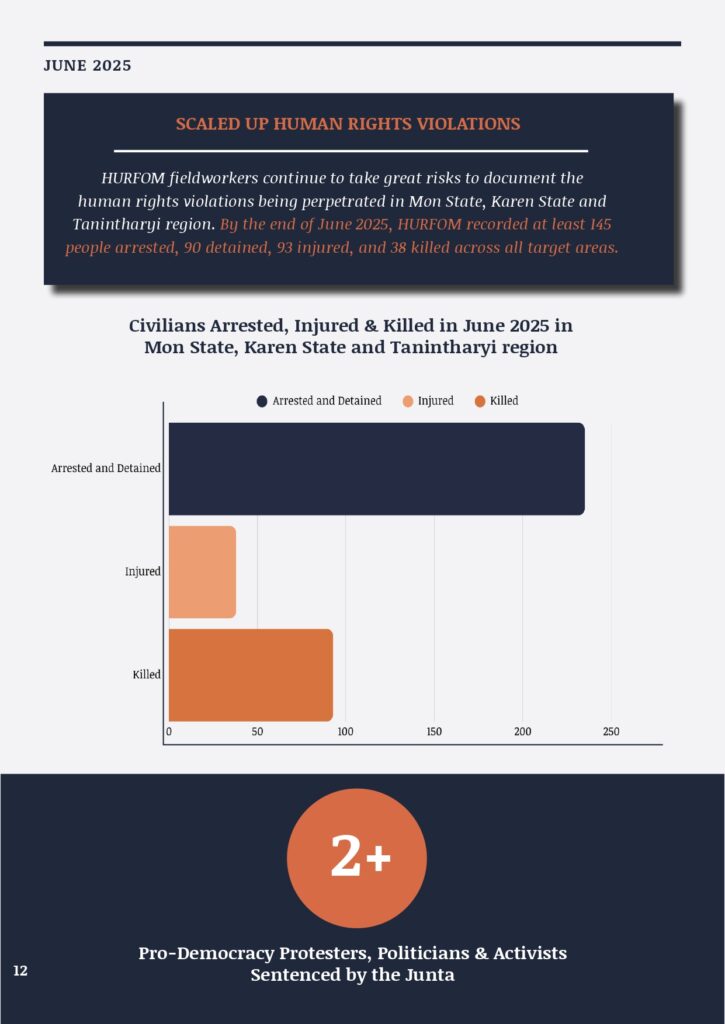
Airstrikes
A tragic airstrike carried out by the junta claimed the lives of a father and his young son in Taung Pyauk Sub-township, Tha Yet Chaung Township, Dawei District, despite no fighting taking place in the area. At 11 AM, a junta jet fighter dropped two bombs on Kyauk Ai village and another two on Mae Kal village. One of the bombs exploded near a house in the Si Pin Chaung Pyar neighbourhood of Kyauk Ai, killing U Than Aung, a man in his fifties, and his 10-year-old son. Four other family members, including his wife, sustained injuries.
“The bomb fell in a quiet civilian area—there was no fighting at all. It’s heartbreaking. A father and his son were killed instantly,” said a villager who witnessed the aftermath.
U Than Aung and his son reportedly died from severe blast injuries. Their home was also destroyed in the explosion. Community members were left shaken and fearful as they tried to rescue and support the wounded.
Sources close to local resistance groups confirmed that the aircraft involved was a military jet, likely dropping 200-pound bombs. Residents believe the airstrike may have been guided by information leaked through pro-junta Telegram channels or military informants operating in the region, who have previously encouraged bombings and arrests in opposition-held areas. Once again, civilians are paying the price for the junta’s escalating attacks, further deepening the fear and trauma already faced by communities across the region.
Arbitrary Arrests
On the night of May 31st, 2025, four individuals were arrested by junta forces in Kan Bauk Sub-town, Yebyu Township, Dawei District, Tanintharyi Region. Among those detained were a Civil Disobedience Movement (CDM) health worker and three members of a non-CDM health worker’s family, according to local sources.
At 11 PM, a group of about 10 soldiers from the Junta’s Mawrawaddy Naval Command arrived in a vehicle and raided two homes in Hlee Gone Wards 1 and 2. They arrested 50-year-old Daw Than Than Maw, a health worker; her daughter, Ma Zin Maw Naing, 27, also a health worker; and her son, Ko Htet Htet, 22. Another health worker, U Kyaw Soe Win, around 45 years old, who has been participating in the CDM since 2021, was also arrested at his home in Ward No. 2.
“There were five family members in Daw Than Than Maw’s home when the troops came. They took three of them. She’s not in good health either. The soldiers said they were just following orders from above,” said a relative close to the family.
Both Daw Than Than Maw and her daughter are reportedly working at the Kan Bauk Sub-township hospital, while U Kyaw Soe Win has been running a private clinic at his home since joining the CDM movement after the military coup in February 2021.
“U Kyaw Soe Win was taken late at night as well. We still don’t know the exact reason. He has been a CDM since the beginning and has treated patients in their homes. The troops came at 11 PM and said they were acting on higher orders, and even asked him to bring extra clothes,” said a friend of U Kyaw Soe Win.
Before the coup, U Kyaw Soe Win had served in the rural health department and the Maternal and Child Health Section in Kan Bauk. After the coup, he joined the CDM and refused to serve under the Junta. All four detainees are currently being held and interrogated at the Mawrawaddy Navy base in Ohn Pin Kwin village, according to local sources. No official charges have been made public yet, and concerns are growing for their well-being, especially given the Junta’s track record of targeting CDM participants and their families.
According to documentation by HURFOM, the Mawrawaddy Navy Unit has arrested more than 20 civilians in recent months, many of them former civil servants and residents who joined the CDM in opposition to the military regime. The wave of arrests reflects ongoing efforts by the Junta to suppress dissent and punish those who stood on the side of democracy and nonviolence.
Artillery Fire
The junta’s attacks are largely indiscriminate, as local populations trying to navigate their daily lives face a constant barrage of assaults that do not spare even the most vulnerable, including young children.
At least three people—among them a five-year-old child—were killed following artillery shelling by junta forces in Long Lone Township, Dawei District, according to local sources. Several homes were also damaged in the attacks. On May 30, junta troops deliberately fired artillery shells into residential areas of Long Lone town. One of the shells struck a home on Pyi Taw Thar Street, killing a father and his young daughter.
“Sayarma Daw Cho’s husband and daughter were inside their house when it was hit. I heard the daughter died instantly, and the father passed away later from his injuries. More than five houses in the area were damaged,” said a resident.
Houses belonging to Daw Mya Nyi, Daw Thin Nyi, and Wanna Phyo in Lower Long Lone town were among those damaged. The next day, May 31, two additional artillery shells exploded near the local market, close to a coconut plantation west of Nyin Maw village. Tragically, a five-year-old girl who had been playing nearby was killed.
“The explosion was very close to her. Her abdomen was torn open by the blast,” a resident shared, visibly shaken.
Clashes between junta forces and resistance groups have intensified near the junta’s base on Lat Khat Taung hill, located between Long Lone town and San Hlan village. Resistance forces launched attacks on junta positions on May 30 and 31, prompting heavy fighting inside Long Lone town. Junta forces have responded with long-range artillery fire from Dawei town, while naval ships stationed offshore have also fired into the area.
As a result of the ongoing violence, more than 2,500 residents from Sat Pyel, Tha Byar, Nyin Maw, and other parts of Long Lone town have been forced to flee their homes. Many are now sheltering in nearby villages and forests, struggling through heavy rains.
Venerable Bhaddanta Indobhasa, the abbot of Thit Seik Pin Monastery in Saw Wa village under the Shin Mot Htee village tract, Dawei, tragically lost his life after being struck by artillery fire launched by junta forces. The incident happened on the afternoon of June 1, following a clash between resistance forces and junta troops near the Shwe Gu Bridge checkpoint along the Myeik–Dawei road. In response to the attack by resistance groups, the junta launched indiscriminate artillery fire toward the surrounding area.
One of the shells exploded within the monastery compound. “The abbot was inside the building when an artillery fragment hit him in the head. He died instantly,” a resident shared. The explosion occurred at 3 PM, causing deep shock and sadness in the local community. Fighting continued around the Shwe Gu Bridge area through the next day, with artillery fire heard well into the afternoon of June 2. During the same conflict, a civilian man in his 30s—living near the base of Shwe Gu hill—was also killed when another shell struck nearby.
Venerable Bhaddanta Indobhasa was 66 years old at the time of his passing and had devoted 46 years of his life to monastic service. As of now, no funeral arrangements have been announced. His death has deeply affected the community, who remember him as a peaceful and respected spiritual leader.
Extortion
Widespread extortion linked to unlicensed vehicles is becoming a significant source of income for junta forces in Mon State. Residents told HURFOM that authorities from the junta’s administration, including the military, police, traffic officers, General Administration Department (GAD), and even village-level security forces, are deeply involved in collecting bribes and exploiting vehicle owners.
Since June 1, the junta has launched a large-scale crackdown on unlicensed vehicles. While claiming it’s part of a law enforcement initiative, the operation has opened the door for rampant corruption, as multiple security branches jointly enforce the crackdown.
“Once they catch an unlicensed vehicle, they demand huge amounts of money from the owners or drivers,” said a Mon State resident who requested anonymity. “At least 3 million kyats per vehicle is demanded just to release it. They often do this in the evenings near main roads, and this has become a business for them.”
Residents pointed out the hypocrisy: when these vehicles were first brought into Mon State, junta-aligned officials allowed their entry by collecting large sums in bribes. Now, those same authorities are arresting and extorting the very people they profited from.
“In many cases, they arrest the driver and confiscate the vehicle,” added another resident. “But if the person has any connection or is willing to pay, they’re quietly released without charges. For others, they threaten imprisonment or impound the vehicle.”
Even minor infractions are being used as excuses for arrests, with some drivers facing up to a month in prison under the pretext of violating import and export laws. However, those with ties to junta officials often pay a bribe and walk free.
“The system is arbitrary and unfair,” said one source close to the local community. “People are scared. They never know if they’ll be asked to pay or be sent to jail.”
Locals also expressed growing resentment toward the junta’s abuse of power. Despite the regime’s supposed rules and regulations, enforcement favours profit over justice.
Since the operation began, hundreds of unlicensed vehicles have been seized across Mon State. Many drivers have been charged under customs and trade laws, while others have faced substantial financial penalties or even more severe consequences.
Forced Conscription
In Bilin Township, Mon State, two young men were arrested and forcibly conscripted into the military by a junta joint inspection team after being caught driving an unlicensed vehicle, according to sources close to their families.
The incident occurred on June 8 near Taung Soon village, along the Yangon–Mawlamyine highway, where junta troops were conducting vehicle inspections. The two youths were stopped, questioned, and later detained after allegedly failing to respond appropriately and for driving without a valid license.
“A relative told us the boys were first taken to the police station. The next day, when the family followed up, they were shocked to learn that the two had already been sent to a military training camp,” said someone close to the family. “Even when they tried offering money to negotiate their release, it didn’t help.”
The two conscripted youths have been identified as Aung Myat Soe (28) and Thet Naing Win, both from Taung Soon village in Bilin Township.
Since the beginning of June, junta forces have been aggressively targeting individuals driving unlicensed vehicles across Bilin Township. Many have faced prison sentences of up to one month, had their cars confiscated, and—if deemed eligible—have been forcibly conscripted into military service. The families of those affected are left devastated, facing not only the fear of losing their loved ones to war but also the helplessness of navigating a system where money and appeals can no longer protect them.
Fear is spreading across nearly every ward and village in Thanbyuzayat Township, as families are being summoned by local administration offices and pressured to draw conscription lottery lots on behalf of their sons, many of whom are currently working or living abroad.
According to residents, on the morning of June 26, the township authorities called on households with males of military service age listed in the family census to report to the local administration office. Even if the young men are overseas, families were told they must draw the military draft lots on their behalf. If the lot is drawn, and the son fails to return to Myanmar to fulfill military service, the Township Administration has threatened legal consequences.
A resident told HURFOM:
“We were called to the office at 10 AM and told we had to draw a lot. There’s no option to refuse. If the lot is drawn, and the son is abroad, we were told we must bring him back to serve. If not, parents will be prosecuted, and the son will be declared a fugitive under a sealed warrant. Everyone here is terrified of what could happen next.”
The threats are reportedly coming directly from township administrators and conscription committees. In some cases, families were warned that if they could not present a substitute conscript, they would need to pay 3 million MMK (~ USD 1,429) to hire a replacement. One official even explained this as the only way to avoid legal action under the People’s Military Service Law.
“They said if your son is abroad and doesn’t come back, we’d have to pay 3 million MMK to find a substitute. If not, we’ll be held responsible. If we can’t find someone to take his place, they’ll punish us under the conscription law,” said another resident.
According to HURFOM sources, these forced obligations have extended to families of overseas workers, migrants, and students. In all cases, families are being forced to take responsibility for their sons’ service, regardless of whether they are still in Myanmar or not.
A local conscription committee member told HURFOM:
“Even young men abroad are included in the draw list, based on household registration data. If the lot is drawn, someone—parent, relative, or a member of the conscription committee—must come and draw for them. If they fail to do so, or if the conscript doesn’t return, authorities will prosecute the parents and declare the son a fugitive.”
Residents said the system is based entirely on the national census and targets all males between the ages of 18 and 35. In Thanbyuzayat and surrounding villages, administrators under junta control have adopted a sweeping approach: every household with an eligible male must participate in the draw.
People are growing increasingly concerned that the junta will start enforcing the use of replacement conscripts or demanding large sums of money from families with no alternative. Those who fail to comply are being told their sons could face restrictions on renewing passports or may be listed as fugitives, subject to arrest and prosecution under the military service law.
The families of young men working abroad are now caught in a painful dilemma: they cannot afford to pay a replacement, nor can they compel their sons to return to a dangerous and unpredictable military service. The junta’s coercive tactics, including threats of arrest, legal action, and fines, are sowing fear and confusion among already vulnerable communities.
This latest strategy—targeting migrants and their families through forced proxy conscription—reveals the Junta’s ongoing desperation to replenish its military ranks. Rather than respecting the dignity and freedom of its citizens, the military is deepening its use of coercion, threatening legal punishment, and turning civilian census data into a tool of repression.
Sham Election
In preparation for the junta’s proposed sham election later this year, the military authorities have begun deploying paramilitary forces under the banner of “Public Security and Anti-Terrorism Squads” to polling station sites across Mon State. According to local sources close to township administration committees, these squads are being mobilized according to population size and township needs, with assignments coordinated at the district level.
These squads, officially announced by the junta on 16 August 2024, are primarily composed of male recruits aged between 35 and 65. They reportedly undergo a one-month basic training and are deployed in groups of around 100 per township. In past elections, special police forces were deployed around polling stations. Still, this year, civilians trained by the junta are being stationed at every polling station—at least two per station—with additional support from police and military forces outside.
“In the past, we saw special security forces as well as the police at polling sites. Now it will be the civilians in blue uniforms. They’ve been trained for just a month, and now they will be guarding polling stations,” said a source close to the Ye Township Administration Committee.
Locals in Paung Township reported that junta authorities have already divided duties among these units for polling station security, urban checkpoints, and even for patrolling unregistered vehicles. Each member reportedly receives a daily allowance of 6,800 kyats and wears an official blue uniform.
“They’re everywhere—at toll gates and checkpoints, in front of government offices, even at intersections. There are about 50 people in one group. Most of them are not professionals; they’re just desperate or jobless locals. And the junta plans to use them when the election starts,” said a resident of Paung Township, Mon State.
In addition to these militarized preparations, HURFOM has also documented the junta’s ongoing efforts to upgrade its surveillance apparatus in Mon State. This includes the continued rollout of the Pan Khin e-ID project, now at Phase 3, which issues digital identity cards embedded with QR codes and 10-digit Unique Identification Numbers. These IDs are gradually replacing the traditional Citizen Scrutiny Cards (CSCs), and data collection reportedly includes biometric details.
The junta’s goal appears to be the creation of a centralized digital population registry, allowing real-time tracking of citizens’ movements and background screenings. Since early 2023, similar systems have been used at airports and passport offices to arrest suspected anti-junta activists and Civil Disobedience Movement (CDM) participants. Recently, these database checks have expanded to highway checkpoints, tightening control on internal travel.
“Local people are already feeling the pressure,” said a civil society member in Mawlamyine. “These surveillance systems, paired with armed checkpoints and election-related mobilization, create fear. Even a simple trip to town feels risky if your name or ID is flagged.”
In rural villages designated as “target locations” for election preparation, residents report the presence of at least 40 Public Security Force members per village, many of whom carry weapons or conduct patrols with the support of police and military personnel. Meanwhile, everyday crimes like theft and drug abuse are reportedly being ignored, with the junta’s focus placed squarely on securing polling areas and suppressing dissent.
Sources close to political parties estimate that by the end of 2024, over 10,000 people across the country will have completed the junta’s so-called public security and anti-terrorism training programs. In Mon State, villagers are being told that mock elections will be held on June 29–30, and that voter registration, security drills, and training for local election officials are currently underway.
“This is not about a real election. It’s about control,” one local rights observer said. “The junta is trying to legitimize itself through force, fear, and fabricated participation. But the people are not blind to this.”
HURFOM will continue monitoring and reporting on the junta’s coercive tactics and sham electoral plans in Mon State and beyond.
Sexual Violence
A horrifying case of sexual violence has emerged from Kanyone Kyun village, where a Junta soldier repeatedly raped a 72-year-old woman during the military’s occupation of the town in mid-June. According to testimonies gathered by HURFOM from residents and eyewitnesses, the assault began after a joint column of Light Infantry Battalion Nos. 406 and 273 entered the village on June 15, reportedly to establish a temporary base. Their arrival sparked immediate fear. While many fled, over 90 villagers, including an elderly couple, were unable to escape and remained trapped under military control.
On June 16, a soldier identified only as “Phoe Chay,” believed to be around 40 years old, arrived at the couple’s home and ordered them to stay hidden beneath their house. A neighbour who witnessed the incident told HURFOM that the soldier returned several times in the days that followed. Tragically, on the night of June 17, the soldier came back and raped the elderly woman three times in one night, in front of her sick and bedridden husband. He threatened to kill the husband if he resisted.
“The grandfather was unwell and couldn’t move. The grandmother, later confirmed to be 72, was too old to flee. The soldier came again on the second night and raped her repeatedly. He warned that he would shoot her husband,” a local villager told HURFOM.
Over two days, the soldier reportedly raped the woman a total of five times. Traumatized and fearing for their lives, the family eventually fled to seek safety elsewhere. The military column reportedly withdrew from Kanyone Kyun on June 25. The survivor and her family are now in hiding, receiving support from local networks. According to the Hninsi Yaung Women’s Union, a Dawei-based women’s rights organization, the woman is undergoing urgent medical treatment for both physical and psychological trauma.
“She can’t remember the exact dates of the assaults, but we believe it happened between June 16 and 23. She is extremely traumatized,” a caseworker familiar with her situation told HURFOM. Local sources also confirmed that junta troops looted homes in the village, stealing valuables and motorcycles, and set fire to at least two houses before their departure.
This alarming case is yet another painful example of the widespread sexual violence committed by the military in areas under its control. HURFOM strongly condemns this horrific act and urgently calls on the international community to ensure justice and accountability for the military’s crimes against civilians, particularly women, the elderly, and those most vulnerable in Burma’s conflict zones.
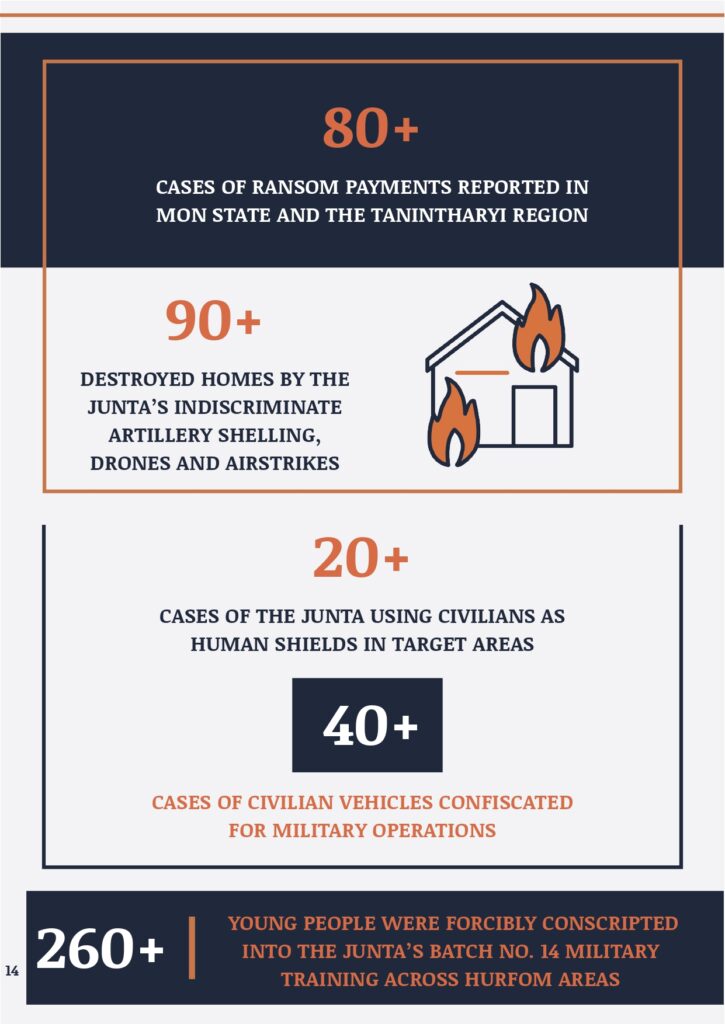
Mon State
Indiscriminate firing in Mon State has taken a devastating toll on innocent communities who continue to have their rights violated and protections undermined in the junta’s attacks. On the evening of June 11, at 5:30 PM, junta forces based in Bilin Township launched an indiscriminate artillery attack that struck Aloo Gyi village, resulting in the death of one civilian and injuries to at least three others. Local sources confirmed to HURFOM that the shelling was unprovoked and occurred in the absence of any active fighting in the area.
The shell was fired from Light Infantry Battalion No. 3, stationed in Bilin town. One of the artillery shells landed directly on a house in Aloo Gyi village, killing 35-year-old Saw Ngwe Lar, a resident. He died on the spot after being hit by shrapnel. The victim leaves behind a wife, Daw Nyo Nwe, and two young children. In addition to the fatality, three other villagers sustained injuries:
- Aung Bo Bo, 28, suffered serious injuries.
- Jit Too, 21, was also wounded.
- Chit Shwe, 45, sustained less severe injuries.
A local villager who witnessed the aftermath said, “It happened suddenly around 5:30 PM. The shell hit the rooftop of a house. One villager, Saw Ngwe Lar, died instantly. He is the son of U Kyaw Aye. Two others were badly injured, and another had minor wounds. There was no clash or fighting here—it was random shelling.”
The artillery blast not only caused casualties but also damaged several homes and destroyed two vehicles. Community members report that this is not the first time junta troops have fired heavy artillery into residential areas from their base in Bilin town.
“The military keeps firing into villages without warning. People are terrified. It can happen any time, day or night,” said another resident.
HURFOM strongly condemns the junta’s ongoing use of artillery in civilian areas, which continues to claim innocent lives and destroy homes. These acts, carried out without provocation and outside of combat situations, are likely to constitute serious violations of international humanitarian law, including war crimes.
In a separate case, a resident was tragically arrested and later found dead after being taken by junta troops who had recently reinforced their presence at the Win Tar Pan military base in Thaton Township, Mon State. On May 30, over 100 junta soldiers arrived at the Win Tar Pan base in Win Tar Pan village. While moving through the area, they detained a 50-year-old man named Saw Lar Hto, who was encountered along the road.
On June 3, villagers discovered his body between Pa Yit Kho and Inn villages, abandoned by the roadside near the forest: “His face and body were covered in bruises and serious injuries. It was clear he had been tortured. Everyone in our village knew the soldiers had taken him,” said a resident from Pain Nal Taw, Saw Lar Hto’s hometown. Saw Lar Hto leaves behind a grieving wife and three children. His death has left the community shocked and devastated.
This brutal killing is yet another tragic example of the junta’s ongoing violence. According to the Assistance Association for Political Prisoners (AAPP), nearly 7,000 civilians have been killed by the junta since the military coup began.
A 52-year-old local man was shot and killed by junta forces near Taung Soon village in Bilin Township, Mon State, according to residents in the area. The incident happened around 5:30 p.m. on June 5, shortly after resistance forces launched a landmine attack on a joint junta force conducting inspections of unlicensed vehicles at a checkpoint near the Taung Soon village bridge.
Following the landmine explosion, which reportedly resulted in two junta soldiers killed and three others wounded, the junta troops retaliated. As they moved through the area, they opened fire on U Zaw Hein Aung, who was riding his motorcycle home from his rubber plantation on the Bilin–Taung Soon road.
“He was just heading back from his plantation. They shot him without warning. The bullet went through his back and side—he died instantly,” said a Taung Soon resident.
U Zaw Hein Aung was laid to rest at the village cemetery on June 6. He leaves behind a wife and four children. This tragic killing follows a similar pattern of retaliatory violence by junta forces. On May 30, in Thaton Township, troops advancing toward the Win Tar Pan military base arrested and killed 50-year-old Saw Lar Hto, a villager from Pain Nal Taw. His body was later found discarded near the roadside, showing signs of severe abuse.
Tensions remain high in Thanbyuzayat Township after junta troops entered Klinepadaw village, Thanbyuzayat, on June 12th and 13th, 2025, arresting ten male villagers. While nine managed to escape during separate clashes, one was tragically shot and killed by the soldiers. According to a 30-year-old eyewitness, the arrests happened suddenly as villagers were returning from rubber plantations near the western slope of Kyeik Gren Hill.
“There were about 40 junta troops, fully armed. As soon as they saw the villagers coming out of the plantation, they rushed forward, grabbed them aggressively, and beat them with the butts of their guns. Some of the villagers fell to the ground,” the eyewitness recalled.
Shortly after the arrests, heavy fighting broke out between junta forces and the local armed resistance forces led by the KNLA. During the clashes, seven villagers managed to flee. The next day, another confrontation allowed two more to escape. Sadly, the last remaining villager was killed by the soldiers.
“The soldiers entered the village and detained ten men. They clashed with the Karen army not long after, and amid the chaos, some managed to escape. But one of them was left behind, and the soldiers shot him,” said a relative of one of the villagers, speaking from Kyarinnseikyi Township in Karen State.
In recent weeks, the junta has launched several military operations in Ye Ta Gon and Lut Shan villages of Thanbyuzayat Township, sparking repeated armed clashes with Mon and Karen ethnic resistance groups. These military offensives have instilled fear and uncertainty among residents, particularly in remote communities with limited phone signal coverage.
“The fighting has become more frequent these days. The soldiers are arresting villagers, and it’s hard to get clear information because communication is so bad,” said a 60-year-old resident of Kyarinnseikyi.
The incident adds to a growing list of junta abuses in Mon State, where arbitrary arrests, violence against civilians, and military raids continue to fuel fear and displacement.
Communities in Kyaukkyi and Mu Townships of Bago Region are once again under siege as junta forces continue their indiscriminate attacks using drones and heavy artillery. According to reports received by HURFOM from field sources and the KNU’s Kler Lwee Htu District, at least three civilians, including an 11-year-old child, were injured. Multiple religious sites and homes were also damaged.
On 14 June 2025, soldiers from the 14th Infantry Battalion No. 264 based in Painzaloke, Kyaukkyi Township, fired two 120mm artillery shells into Hpan-talin village and one shell into Thamin Inn Gone village. The shelling injured 26-year-old Naw Gee Lah Paw from Thamin Inn Gone, 42-year-old Naw Mu Mu, and 11-year-old Saw Daung Pyuk from Hpan-talin village.
On 17 June, junta forces launched another round of 120mm artillery shells—three in total—into Thamin Inn Gone village, causing further panic and displacement among residents.
Just days later, on 20 June, junta soldiers based in Than Kwin, Mu Township, escalated their campaign. Twelve drone-dropped bombs were released over Ohnshik Gone village. Meanwhile, Yaele and Laekwinpyin villages were hit with several more 120mm artillery shells.
These attacks left at least four civilian homes in Ohnshik Gone and Yaele villages destroyed. Among the damaged structures were a Buddhist monastery and a Christian church in Ohnshik Gone, which had once served as safe spaces for spiritual and communal refuge. Local residents told HURFOM that these villages are not conflict zones and were not experiencing clashes at the time of the attacks:
“There was no fighting in our area. People had already fled in fear long ago, but their homes were left behind,” a local man said.
“What the junta is doing here is not just wrong—it’s illegal under international law. These attacks are hitting our homes, schools, and even our places of worship. That’s a direct violation of the Geneva Conventions, which clearly say you cannot target civilians or religious buildings. They’re supposed to protect life, not destroy it.
Dropping bombs on villages where there’s no fighting, where people are just trying to survive, is a serious crime. International humanitarian law is obvious—civilians must be protected at all times, and there must be a clear distinction between soldiers and ordinary people. But the junta doesn’t care. They’re breaking the laws of war, and they’re doing it openly. It’s cruel, it’s calculated, and it’s meant to terrorize us into silence,” said a human rights educator and community leader from Brigade 6 under KNU administration, speaking to HURFOM during a field mission on June 23, 2025.
Local villagers from Taung Yar Kan in Palaw, as well as from Kyaukkyi and Mu, continue to flee their homes in fear of the next attack—many of them now living in makeshift shelters with little access to humanitarian support.
Karen State
At least six civilians, including three children, were killed when junta aircraft dropped bombs on Pai Yap village in Kawkareik Township, Karen State. The airstrike occurred at 2 PM on June 9, despite no ongoing clashes in the area. Eyewitnesses reported that five bombs were dropped directly onto the village, causing significant destruction.
One of the bombs hit a house being used as a classroom, where students were attending lessons. Among those killed were three young children, a female teacher, and two other residents. The injured were rushed to Kanyin Katai hospital with the support of local humanitarian teams and are currently undergoing treatment. Earlier that morning, junta aircraft were also seen attacking the Kyondoe area. The same day in the afternoon, they targeted Pai Yap again with airstrikes, villagers confirmed.
Since June 6, the junta has increased its military presence in both Kawkareik and Kyondoe, launching continuous air and artillery attacks on civilian areas. Just two days prior, on June 7, the military bombed Ohntapin village in Kawkareik Township, injuring four civilians—one of them seriously. HURFOM condemned this attack in a statement on June 11.
Although the junta has declared a temporary ceasefire across the country until June 30, the situation on the ground tells a different story. Their continued attacks have led to growing mistrust among civilians, who no longer believe in the sincerity of the junta’s public statements.
Tanintharyi Region
More than 13 residents from Yebyu Township in Dawei District remain in junta custody following their abduction on May 28, and they have yet to be released as of May 30. The junta troops, who were advancing toward the Dawei Special Economic Zone from Yebyu town, reportedly detained at least six people from Ya Line village, four from Kha Maung Chaung, and three from Pa Kaw Zun. Those taken include both men and women.
“They were simply cutting grass in the forest when they encountered the soldiers and were taken away. The troops arrested everyone they saw—young people, older adults, even couples,” said a resident familiar with the situation.
The abducting military column is currently stationed near Aye Kan Ni village. On the morning of May 29, a clash broke out between junta troops and local resistance forces. According to a source close to the resistance, the detained civilians are still being held and are being moved along with the military unit. As of midday on May 30, the troops were seen retreating from the forested area near Aye Kan Ni village, but there has been no update on the condition or whereabouts of the abducted residents.
As fighting intensifies in Long Lone Township, Dawei District, local sources have confirmed that junta troops reinforcing the area have arrested at least 15 displaced villagers they encountered on the road. On May 30, while travelling through forest routes from Dawei toward Long Lone for reinforcement, junta troops apprehended several internally displaced persons (IDPs). Among those detained were four villagers from Tha Byar, who had been sheltering in the area, and eleven residents from Long Lone Town, according to sources close to the families.
“Most of those arrested were IDPs returning from forest shelters during the fighting. They were captured along the way,” a Long Lone resident told HURFOM.
The troops arrived in Tha Byar on May 31 and detained four more people. The others were arrested en route, including women and individuals aged between 20 and over 50. In a hurry, the soldiers left behind motorcycles and rations along the roadside. On the morning of June 1, the column was seen advancing toward Lat Khat Taung, a mountainous area located between Long Lone Town and San Hlan village.
Since May 30, heavy clashes have persisted between resistance forces and junta troops in the vicinity of Long Lone and Lat Khat Taung. The junta is using artillery to shell Long Lone Town and nearby villages indiscriminately, forcing thousands of civilians to flee despite the ongoing heavy rain. Many have had to leave their homes and belongings behind, adding to the growing humanitarian crisis in the area.
On June 7, the military junta launched an aerial attack using a fighter jet on two villages—Kyauk Eye and Mell Kell—in the Taung Pyauk area of Tha Yet Chaung Township, Tanintharyi Region. According to the Karen National Union’s statement released on June 8, there were no armed clashes in the area at the time. Despite this, the junta’s fighter jet dropped two bombs on each village, killing a father and his young son, and injuring six others.
One of the bombs exploded near a home in Zee Pin Chaung Phyar Ward, Kyauk Eye village, killing 55-year-old U Than Aung and his 10-year-old son, Saw Than Win Htwe. The blast also injured six villagers, including U Than Aung’s wife, and destroyed both their house and a vehicle.
“It may have been a 200-pound bomb. U Than Aung and his son were killed instantly by the impact and flying debris. Their home and car were destroyed. His wife and the others are now receiving medical treatment, but their conditions remain unclear,” said a resident.
Villagers reported that although no fighting was taking place in the area, the junta has been carrying out sporadic airstrikes in Taung Pyauk since March 2025.
“There were no clashes—this was a deliberate attack. The bombs were dropped so suddenly that people didn’t even have time to react. They just ran in every direction,” one villager shared.
This incident is not isolated. On March 3, a junta fighter jet bombed the closing ceremony of a school operated by the National Unity Government, injuring four people, including another 10-year-old child.
Troop movements and intensified ground operations by the junta’s Coastal Regiment Command in Laung Lon Township, Tanintharyi Region, have once again forced hundreds of civilians to flee their homes as fear and insecurity grow across multiple villages.
According to HURFOM field reporters, junta troops—approximately 60 soldiers in strength—entered Sakhan Gyi village on 16 June and began occupying a local monastery where internally displaced persons (IDPs) had temporarily sought shelter. The troops then moved from village to village, including Khamaung Taung and Taung Min Pyaung, using these locations as temporary bases.
“They’re stationed all around our village. If we step outside, there’s a high chance we’ll be detained or mistreated,” said a woman from an IDP family who fled on June 17. “Even if they haven’t fired directly into the village, we hear artillery from nearby every day and night. It’s terrifying. If they want to arrest someone, they just do it, and sometimes, people simply disappear without any trace. That’s why we decided to leave, even if we didn’t know where we’d end up.”
The military column continued its movement on June 17, advancing from Sakhan Gyi to Taung Min Pyaung village, where it stationed troops inside a monastery again. As a result, not only residents from Taung Min Pyaung and Khamaung Taung, but also nearby villagers from Phwar Bote Pyin, have fled for safety. Local sources reported that the junta forces are using an aggressive village-by-village advance strategy, making neighbouring communities increasingly fearful that their village could be next. Many residents are packing up and fleeing preemptively, leaving behind homes, farms, and possessions.
At the same time, junta troops operating in the southern part of Laung Lon Township have also continued troop deployments and arrests. Villagers from Wai Dee, Pyin Htain, Sit Pyae, Nyin Maw, Lay Thone Khan, Ka Htaung Ni, and Kanyone Kyun have been forcibly displaced in recent days. HURFOM’s monitoring confirms that more than 40 villagers have been arbitrarily arrested during these raids.
In a related concern, junta naval ships have been patrolling the Dawei River, firing artillery toward riverside villages. Some unexploded shells have landed in farmland, causing further anxiety for farmers as they fear for their lives while tending to their crops.
Many residents believe these military operations are connected to attempts by the junta to prevent public gatherings on June 19, the 80th birthday of detained democracy leader Daw Aung San Suu Kyi. The intensified military presence is widely seen as a deliberate move to block any peaceful commemorations or expressions of solidarity.
“The army doesn’t need a reason to come into our villages anymore. Even without fighting, they arrive, occupy, and people have to flee. We just want to live peacefully—but they’re turning everything into a war zone,” said a 48-year-old resident from Lay Thone Khan who is now displaced with her two children.
Two civilian homes were destroyed in Taung Yar Kan village, Palaw Township, Tanintharyi Region, after junta forces launched indiscriminate artillery and drone attacks. According to local sources, the attack happened despite no active clashes in the area at the time. On June 20, 2025, at around 12:00 PM, the junta troops based in Palaw fired two rounds of heavy artillery and dropped two bombs from drones into Taung Yar Kan village. The weapons directly struck civilian areas, destroying two homes and sending shockwaves through the few remaining residents.
“There was no fighting that day. The villagers had already fled because of the repeated attacks. But even though people weren’t there, their homes were hit and destroyed,” a local witness told HURFOM.
The damaged houses were traditional wooden structures, now completely reduced to rubble. Locals confirmed that the attack came without warning and had no apparent military justification, echoing a pattern of violence against civilian areas that has continued for over a year.
Junta offensives have repeatedly targeted Taung Yar Kan and other nearby villages in Palaw Township. Since early 2024, HURFOM has documented escalating incidents of artillery shelling, drone bombings, arbitrary arrests, and looting by military troops under the Coastal Regiment Command and Navy-aligned units based in Mawrawaddy and Palauk.
Palaw Township—strategically located between Dawei and Myeik—has become one of the most heavily militarized areas in Tanintharyi. Junta forces frequently use civilian roads and villages as operational zones. Villagers report that the junta has used the presence of resistance groups as a justification to launch disproportionate and illegal attacks.
In one case in May 2025, four civilians from Sitpyin Gyi village, a neighbouring village of Taungyar Kan, were arrested—including non-CDM health workers—on mere suspicion of communication with local resistance forces. They were held incommunicado for more than two weeks before finally being released. No charges were ever filed. Taungyar Kan village is just over one mile from Palaw town, and the fear of further shelling has left only a small number of residents in the area. Those who remain live in fear and uncertainty, hiding during the day and relocating at night.
Repeated attacks have also targeted places of worship and education. On June 4, junta forces fired artillery into Du Yin Pin Shaung village, damaging a Christian church. No fighters were present in the area at the time. Locals say this systematic pattern of intimidation and destruction aims to break the spirit of rural communities and prevent support for resistance forces, while asserting military control through violence.
“The junta is treating our villages like battlegrounds, even when no fighting is happening. They use fear to control us, and they destroy our homes to send a message,” said one displaced woman from Palaw, now sheltering in an informal camp near the Thai-Burma border.
According to local sources, on the morning of June 19, the junta forces used a bulldozer to demolish the family home of a couple who had been arbitrarily arrested two days earlier in Paya village, under the Ohn Pin Kwin village tract. The house, located in Shar Gone Ward of Paya village, belonged to the parents of Aung Ko Thet and his wife, Mee Chu, who were taken from the property around 1:40 PM on June 17. Residents stated that the house was a one-storey concrete building that was destroyed without any prior notice or justification.
“They were arrested from their parents’ home, and then, two days later, soldiers came back with a bulldozer and tore it down,” said a male resident from the area. “Both of them were beaten during interrogation right after being taken, and later transferred to the Mawrawaddy Naval Command.”
The arrest occurred shortly after clashes between local People’s Defense Forces (PDFs) and junta troops broke out in the area. On the same day, June 17, four people were reportedly detained by the military in connection with the fighting—two from Shar Gone (the arrested couple), and a father and son from Khwaymahpaw village.
Community members believe the junta accused all four of having ties to the resistance, specifically linking them to attacks that occurred on June 15, when three junta outposts near Shwe Moe Nyo Pagoda in Paya village came under coordinated assault, resulting in three junta soldiers being killed. The junta’s use of collective punishment—arresting civilians without a warrant and destroying private property—is a grave violation of international human rights and humanitarian law. Local communities remain fearful as military operations escalate in Yebyu and surrounding areas.
The lifeless body of a local villager who junta soldiers forcibly took during their retreat from Kanyone Kyun village was discovered. On June 24, as junta troops from a joint column were withdrawing from Kanyone Kyun village, local sources confirmed that they had abducted several villagers. The body of U Myo Zaw Aung, aged 46, was found dumped in a palm plantation between Sit Pyae village and Laung Lon town. The victim had been detained earlier during the junta’s occupation of Kanyone Kyun, which began when Light Infantry Battalion forces launched an operation from Laung Lon town on June 14. They occupied the area for ten days before retreating on June 24. Residents told HURFOM that more than 100 villagers from Kanyone Kyun and surrounding areas were detained during the occupation.
Among those taken, U Myo Zaw Aung was a civilian known to suffer from mental health challenges. His body showed clear signs of brutal torture. Visible wounds suggest he endured severe abuse at the hands of junta soldiers before being killed—his throat had been slashed. Witnesses believe his death occurred during or shortly after the military’s retreat.
“He wasn’t involved with any armed groups or political activities—we know that for sure because we live in the same village. He had mental health challenges and mostly kept to himself. It’s heartbreaking to find his body like this,” said a resident who knew the victim well. In addition to the killing, local sources confirmed that junta troops burned down two houses and looted homes, stealing valuable items and several motorcycles during their time in the village.
Although most of the approximately 100 detained villagers were released on June 25, three residents of Kanyone Kyun remain in custody. Their families have not been informed of their whereabouts or condition.
[Download the full report | Burmese]



